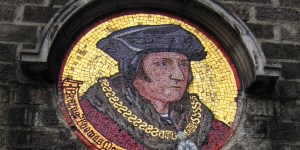Lenten Campaign 2025
This content is free of charge, as are all our articles.
Support us with a donation that is tax-deductible and enable us to continue to reach millions of readers.
Picture the scene. It’s the first day of December in 1581. A crowd has gathered at Tyburn, the place in London where criminals are executed, to witness the martyrdom of Edmund Campion. His crime was being a Jesuit priest. This made him an enemy of the state, guilty of “treason,” for which the punishment was slow, torturous death by hanging, drawing and quartering.
One of the faces in the crowd watching this grisly scene was that of Henry Walpole, a young lawyer. Somewhat sympathetic to Catholicism but lukewarm in matters of faith, he watched horror-struck as the executioner prepared to cut open Campion’s body, while the victim was still alive, in order to remove the internal organs. As the knife cut into the writhing body, some of the blood splattered on Walpole’s clothes. The moment was lifechanging. Having been baptized in the blood of a lamb who had laid down his life for Christ, he abandoned the practice of law intent on giving his own life to the Christ for whom Campion had died.
He wrote a slim book of poetry in honour of Edmund Campion which was published by a secret Catholic press. The publisher was arrested and tortured in an effort to get him to confess the name of the poet whose verse he had published. Although his ears were cut off during the torture, the publisher did not betray Walpole’s identity.
Coming under increasing suspicion, Walpole went into exile. In 1583 he entered the English College in Rome to study for the priesthood and in the following year entered the Jesuit order intent on following in Edmund Campion’s footsteps. In 1588 he was ordained to the priesthood. In the same year, at considerable personal risk, the great court composer William Byrd published his own musical setting of three verses of Walpole’s poem, “Why Do I Use My Paper, Ink and Pen”. This is the first verse:
Why do I use my paper, ink and pen?
And call my wits to counsel what to say?
Such memories were made for mortal men;
I speak of Saints whose names cannot decay.
An Angel’s trump were fitter for to sound
Their glorious death if such on earth were found.
Betrayed
Twelve years to the day after he had witnessed the martyrdom of Edmund Campion, Father Walpole was on a ship heading for England. Tragically, he was arrested shortly after he had landed in Yorkshire, having been betrayed by a member of Queen Elizabeth’s spy network. He would spend the next 16 months in prison, first in York and then in the Tower of London, where he was tortured repeatedly by Elizabeth’s chief priest-hunter and torturer, Richard Topcliffe.
Father Walpole was tortured on the rack and suspended for hours by his wrists on no fewer than 14 occasions, each session being spread apart to avoid the risk of death under interrogation. In between these sessions, while incarcerated in the Salt Tower, he carved his name in the wall. The cell containing this godly graffiti is now a place of prayer for those who visit the Tower of London as pilgrims, not merely as tourists.
The charge was simply being a Catholic priest, which was enough in itself to be hanged, drawn and quartered for “treason” in Queen Elizabeth’s England.
In the spring of 1595, Father Walpole was sent back to York to be tried along with another Catholic priest, Alexander Rawlins. The charge was simply being a Catholic priest, which was enough in itself to be hanged, drawn and quartered for “treason” in Queen Elizabeth’s England. The judges demanded that the two priests take the Oath of Supremacy, acknowledging the queen's complete authority in religion. After refusing to comply, their fate was sealed.
Picture the scene. It’s April 7, 1595. A crowd has gathered at the Knavesmire, the place in York where criminals are executed, to witness the martyrdom of Henry Walpole. His crime was being a Jesuit priest, a “crime” he committed willingly in order to follow in the footsteps of Edmund Campion, whose blood had led to his conversion. He had followed his saintly predecessor all the way to the gallows and all the way to heaven. Both men were canonized by Pope Paul VI in 1970 as two of the Forty Martyrs of England and Wales.
Today is St. Henry Walpole’s feast day. On this, the 430th anniversary of his martyrdom, we should honor his name and ask for his prayers.









